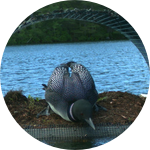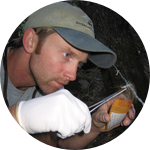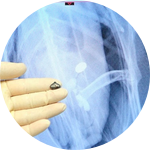About This Project
Many species of wildlife are exposed to lead in the environment, sometimes with devastating consequences. Some impacts are highly visible and well-documented, but many lesser-known species may be heavily impacted by lead poisoning too. Active surveillance is used to minimize the harms of lead poisoning, particularly in children. We aim to develop a system of active surveillance for lead poisoning in wildlife based on wildlife rehabilitation patients and hunter-harvested waterfowl.
Ask the Scientists
Join The DiscussionWhat is the context of this research?
Since the first report of lead poisoning in ducks that had eaten spent lead shot in 1894, lead poisoning has been documented in numerous species of wildlife in almost all parts of the world. Understanding the sources of exposure in wildlife is critical to mitigating impacts on wild animals. We need to understand where and how wildlife are exposed to heavy metals before before we can achieve changes that will make a real impact. Lead exposure represents a risk both to species of conservation concern, and also a public health threat to people consuming wildlife. Environmental lead exposure is an overarching one health problem.
What is the significance of this project?
Lead poisoning surveillance in wildlife is generally a mixture of passive surveillance (testing sick animals, usually at rehabilitation facilities) and term-limited specific research projects. Only a minority of high conservation-value species (e.g. California Condors) are subject to active lead exposure surveillance.
Active surveillance for lead exposure in humans is based on identifying at-risk populations and locations and proactively testing patients regardless of clinical signs. This allows early intervention and harm minimization as well as allowing epidemiologists to build a spatial and demographic picture of the problem to better understand the risks.
What are the goals of the project?
We aim to apply this active surveillance approach to lead poisoning in Northeastern wildlife by: 1. Developing a screening protocol in collaboration with wildlife rehabilitators and veterinarians to determine the best 'at-risk population' to sample actively, 2. Collect and test blood, feather and (where available), tissue samples for lead, 3. Collect and test blood and feather samples from waterfowl harvested by hunters.
Our student intern will work on a project using ArcGIS to build a database of exposure sources of lead and map the locations of animals tested for lead exposure. The purpose is to spatially map the lead exposure data we collect with current and historical point sources of lead (e.g. mines, industrial facilities).
Budget
This project budget will allow us to fund a student stipend to work on building a GIS database of potential lead point-sources in the environment. Meanwhile we will develop an active surveillance system for screening and testing wildlife for lead exposure through patients in wildlife rehabilitation facilities and samples collected by hunters targeting waterfowl.
Endorsed by
 Project Timeline
Project Timeline
Beginning summer 2019, this project will run for approximately one year. It is part of a larger, long-term project covering lead exposure risk in wildlife. The data collected in this study will also help us to apply emerging stable-isotope methods to refine to location of sample origin based on where the individual animals were feeding at the time of exposure. Samples collected in this study will be archived for future stable-isotope analyses and diagnostic testing.
Jun 03, 2019
Project Launched
Jul 01, 2019
Project Launch
Aug 31, 2019
Planning and identification of archived samples.
Sep 30, 2019
Case definition for rehab-based active surveillance
Dec 01, 2019
Hunter sample collection
Meet the Team
Affiliates
Affiliates
Tristan Burgess
Tristan is a wildlife veterinarian and epidemiologist. His research investigates i) the effects of disease on ecosystem processes; ii) the ways in which health and disease can impact, or be used to measure, conservation outcomes; and iii) the intersection of behavioral/foraging ecology and animal health. Tristan also consults on wildlife health management for state and federal governments as well as some of the finest zoos and aquaria in the US. He has handled and worked with a wide range of captive and free-ranging wildlife from lions and Tasmanian devils to penguins, pinnipeds and sea otters.
Mark Pokras
Dr. Mark Pokras is a wildlife veterinarian who has been working on conservation projects in the US and abroad for nearly 50 years. He has worked extensively on lead poisoning in a variety of species (including people) and has led a study on environmental health threats to Common Loons for over 30 years, collaborating with a wide variety of agencies, NGOs and citizens groups across the US and Canada.
Associate Professor Emeritus
Wildlife Clinic & Center for Conservation Medicine
Cummings School of Veterinary Medicine
Tufts University
N. Grafton, MA USA 01536-1895
Jim Killarney
Jim is an analytical and environmental chemist. His work focuses on 1) Developing water quality monitoring techniques and tracking harmful algal blooms using images collected from unmanned aerial vehicles (drones) and 2) Measuring the movement of pollutants through aquatic ecosystems.
Caroline Neville
Caroline is the staff veterinarian at Avian Haven, a wild bird rehabilitation center located in Freedom, Maine. Avian Haven treats almost 3000 patients per year and commonly sees birds affected by lead poisoning.
Project Backers
- 98Backers
- 100%Funded
- $4,212Total Donations
- $37.88Average Donation





